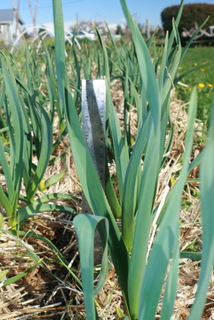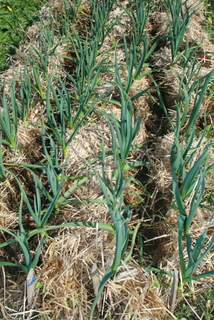
Garlic goes through four stages in its life: a dormant stage over winter when it conserves energy and growth is slow; a spring spurt when growth is rapid; a flowering stage in June when energy is directed at producing scapes, bulbils, and seeds; and the bulbing stage, when it sends the last of its reserves toward growing a bulb that can split into cloves and carry on in the next season.
If you’ve tucked your garlic in under mulch for the winter, now is the time to pull back the blanket and let the sun shine in. Early spring is a time of intense change for the garlic plants, and when they first come up, they are hungry! Have pity and don’t make them search for food!
Think of your garlic like other leafy green vegetables. It will visibly respond to a quick nitrogen fix. The bigger, stronger, and more lush it grows now, the more resources it will have to make bulbs (make that Big Luscious Bulbs bursting with flavor) later.
My strategy is a combination of blood meal, kelp, fish fertilizer, and worm tea. But you don’t want to overdo it. For the first application, I work a little blood meal into the soil. A couple of weeks later, I give them weekly applications of a foliar spray of diluted fish fertilizer and ground applications of worm tea and kelp. I cut all stimulants when I get close to harvest, cold turkey.
So I went out early this month to check the status of my bulbs, and they were already a foot and a half tall! (Living proof! See the picture at left!) I tentatively pulled back the hay mulch, which if you’ve been following this blog, you know I piled it on rather thickly this last winter. In some places, it was a little too thick. Although it helped filter all the heavy rain we’ve had and moderate the dips below freezing, it was also holding all that moisture in. I pulled it back from every other row. The ground was cold and wet. A few of the bulbs were really struggling to get through, and whew! I think I rescued them just in time. I could almost hear them say, “Ahhh – fresh air! Sunlight! I can breathe!” I could visibly watch them straighten out and reach for the sun.

“Hang in there. I have what you need,” I told them. But before applying the blood meal, I had to do a little math. It always surprises me how much math is involved in gardening. I have four 3.5-foot beds 20-feet long with four rows of garlic down each bed. Ok, so how many square feet is that and how much blood meal should be applied per plant, square foot, acre, or hectare, based on recommendations on the box. In the end, I sprinkled a small amount down the rows, which amounted to 4 cups per bed, which miraculously used up the whole 5-lb box over the entire plot. I love it when things turn out even. As noted above, I lightly worked the meal into the top inch or so of the soil, which also broke up the upper crust and worked some air into the ground. I was careful not to dig around too deeply. The roots are long, spindly, and rather brittle. You have to use care not to break them. I pulled an occasional dandelion weed, which came out easily in the soft beds. I cut off some of the weeds growing along the sides of the beds and threw the cuttings on top of the mulch. I don’t want to disturb things too much at this point. The weeds aren’t so bad that they are suffocating my friends. They’re just helping to hold things together. When things dry out a bit, I will turn over the weeds growing in the pathways. For now, everyone was lookin’ good. I walked away.
The next day, we were hit with 60-mph winds. I thought of my poor plants out there, naked and exposed and getting whip lash. I didn’t want to go out there. It was obviously not a safe place for cats or, for that matter, even small children. I woke up the following day to thick frost and a hard ground. A few days later, we were getting slushy rain mixed with snow, blowing sideways. Will this never end? Sometimes we just can’t predict these things. My garlic are strong because they have to be. We get character-building weather in late March and early April.
Was it too early to feed them? I don’t think so. And if you haven’t fed yours, never fear, it isn’t too late.
Not surprisingly, everyone survived just fine. When in doubt, keep in mind that some of these grow in Siberia. Garlics are by nature hardy souls.
But with regard to fertilizer, there can also be too much of a good thing. The blood meal is relatively slow release, but it is still strong. I probably won’t add any more this season. This next week I will start routine applications of diluted worm tea and fish fertilizer. The garlics really perk up after each of these feedings.
So. Listen to your plants. Be sensitive to their needs. Feed them. Water them. Give them air. When the weather fools you, encourage them to hang in there. A little TLC now will be greatly repaid later. Some people might think me a little fanatic, but what do you expect when the majority of your friends are garlic plants? I am ok with that. I have no trouble consuming them. Not even a twinge of remorse. My philosophy: Feed the garlic and they will feed you. Rather well, actually.